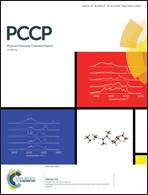Aromatic cage-like B34 and B35+: new axially chiral members of the borospherene family†
Abstract
Shortly after the discovery of all-boron fullerenes D2d B40−/0 (borospherenes), the first axially chiral borospherenes C3/C2 B39− were characterized in experiments in 2015. Based on extensive global minimum searches and first-principles theory calculations, we present herein two new axially chiral members to the borospherene family: the aromatic cage-like C2 B34(1) and C2 B35+(2). Both B34(1) and B35+(2) feature one B21 boron triple chain on the waist and two equivalent heptagons and hexagons on the cage surface, with the latter being obtained by the addition of B+ into the former at the tetracoordinate defect site. Detailed bonding analyses show that they follow the universal bonding pattern of σ + π double delocalization, with 11 delocalized π bonds over a σ skeleton. Extensive molecular dynamics simulations show that these borospherenes are kinetically stable below 1000 K and start to fluctuate at 1200 K and 1100 K, respectively. The IR, Raman, and UV-vis spectra of 1 and 2 are computationally simulated to facilitate their experimental characterization.



 Please wait while we load your content...
Please wait while we load your content...